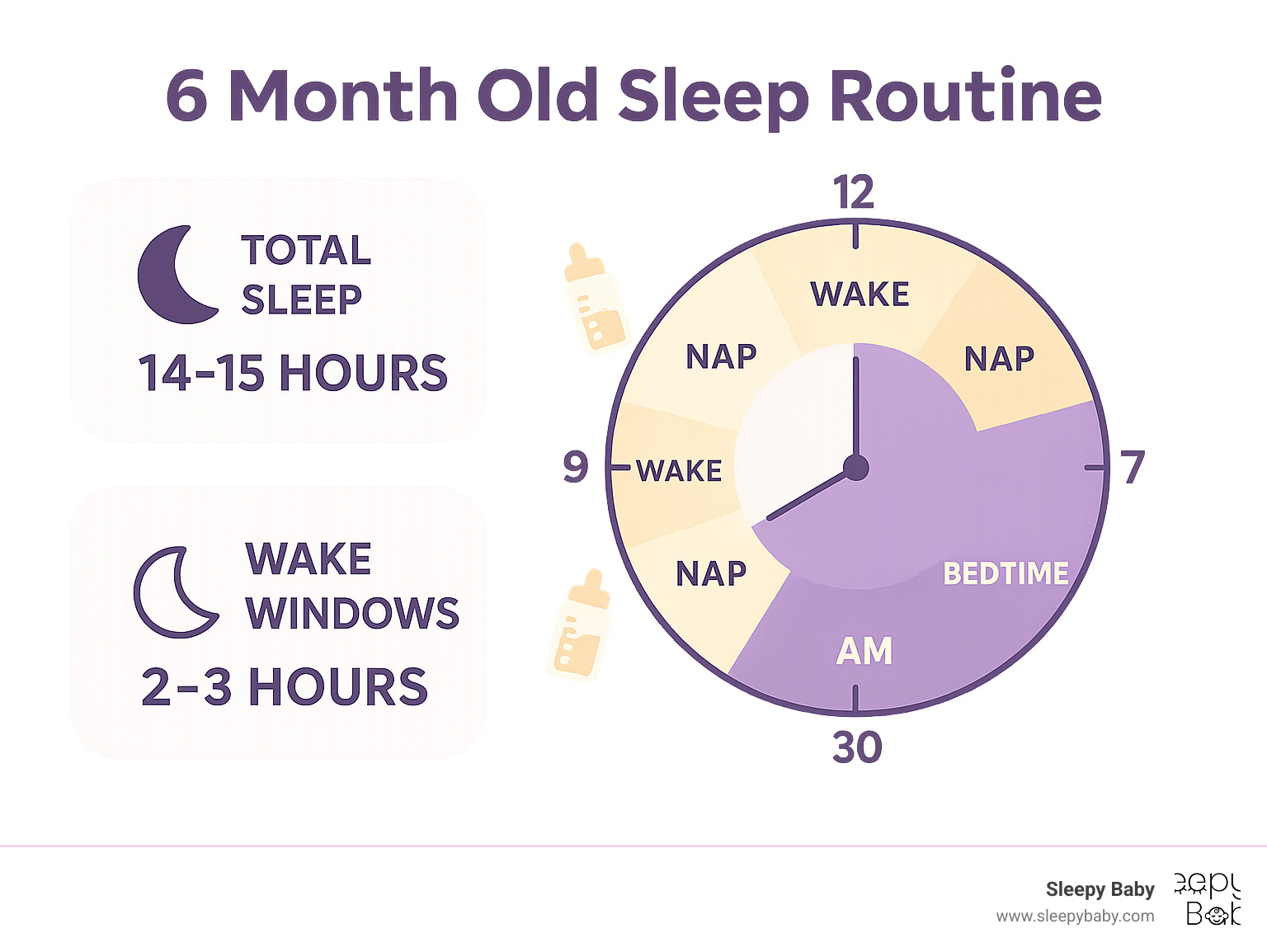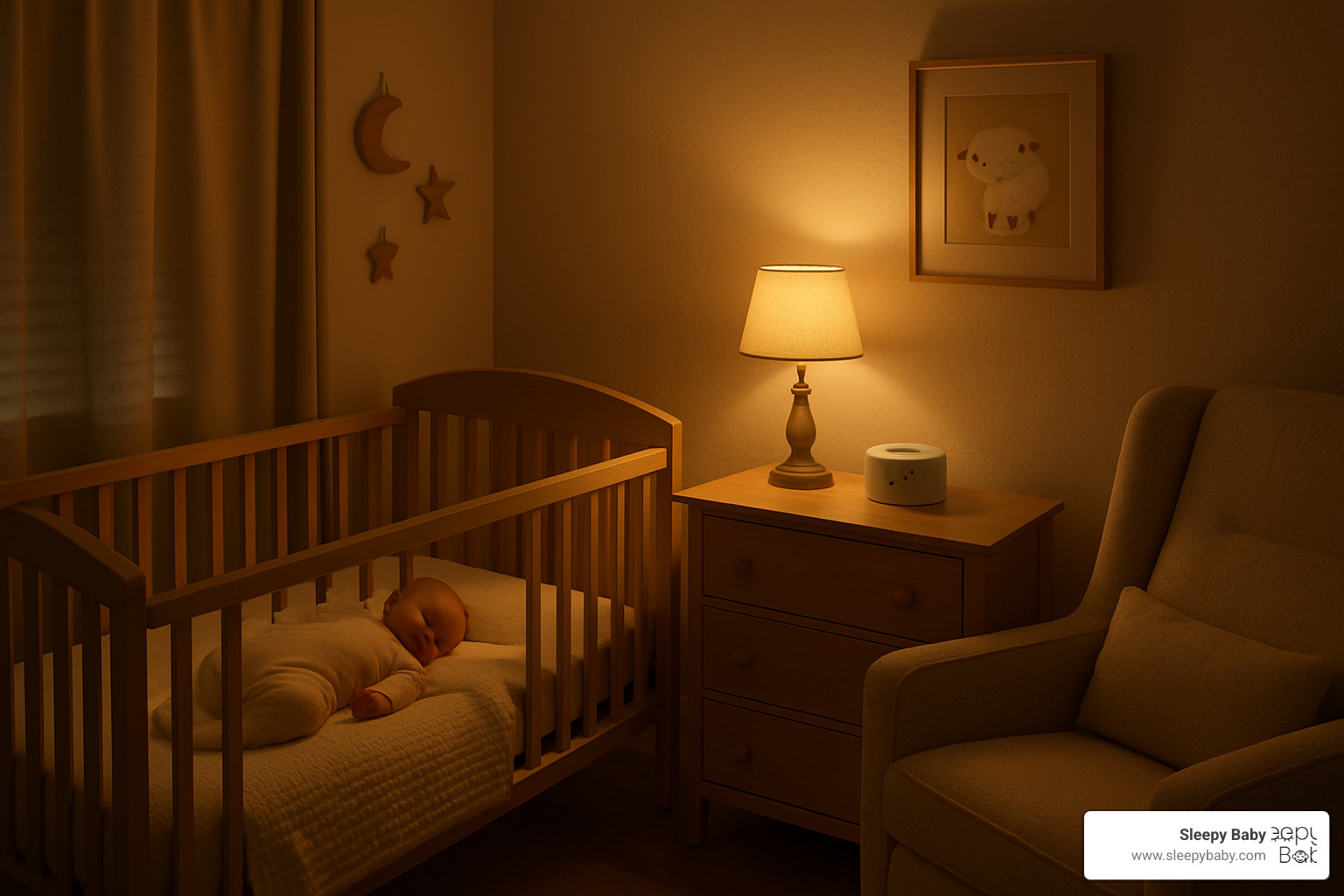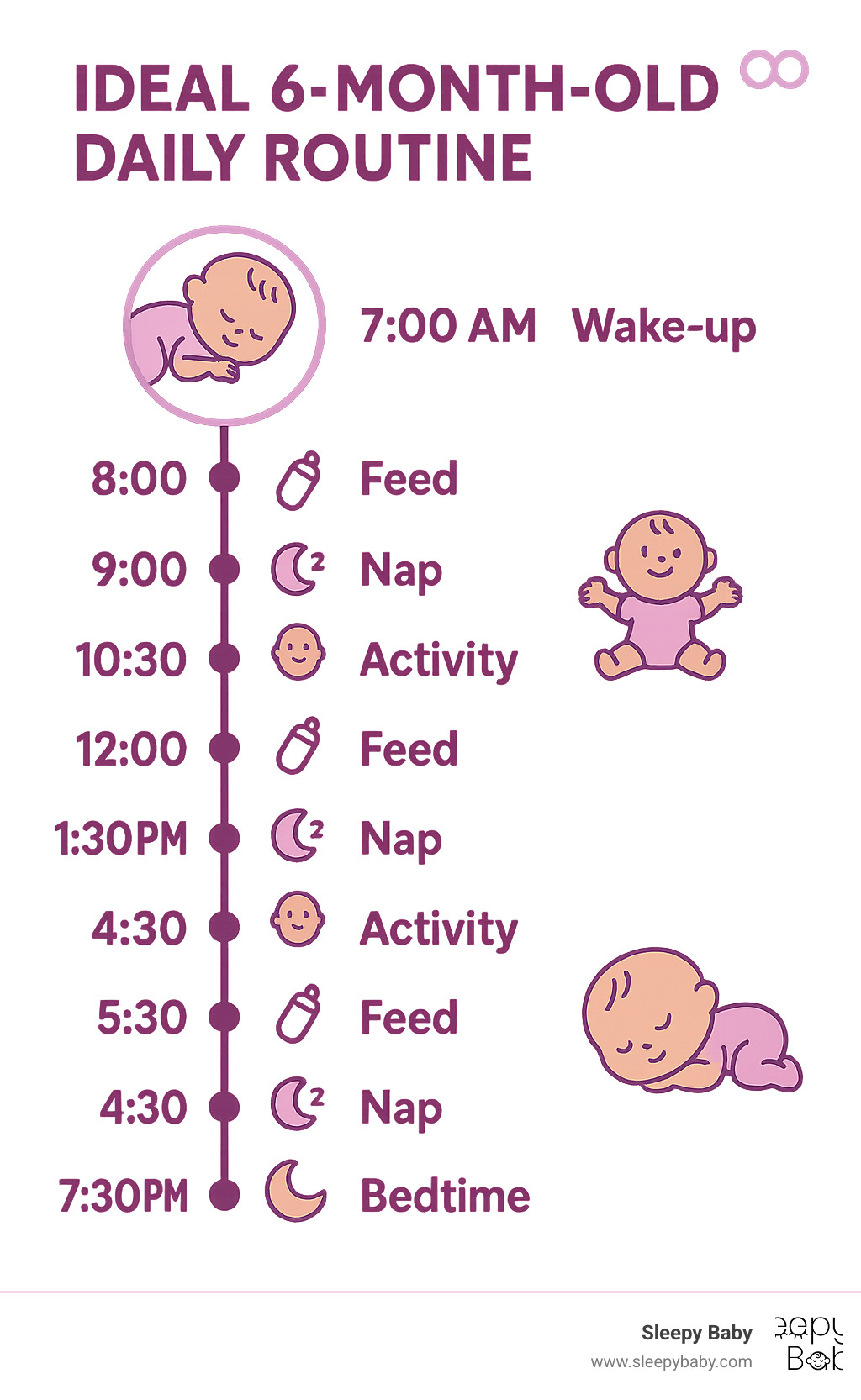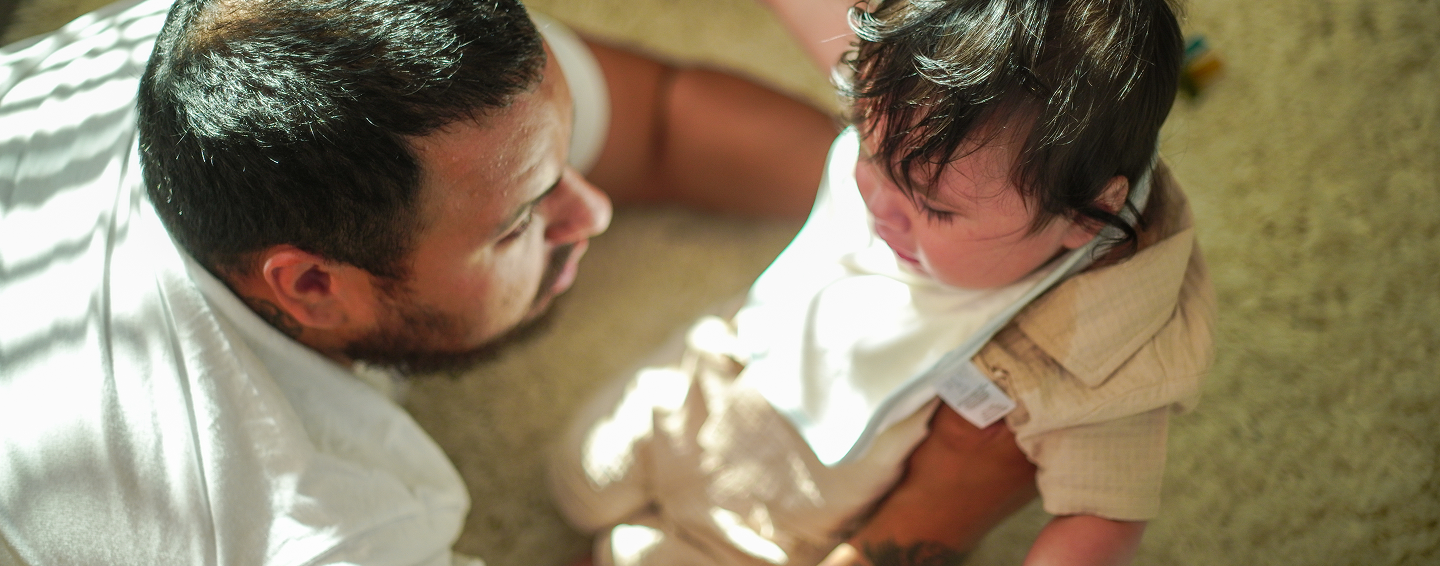Why Your 6 Month Old Sleep Routine Is the Key to Better Nights
At six months old, your baby has reached a crucial sleep milestone. A well-structured 6 month old sleep routine can transform chaotic nights into peaceful rest for your entire family.
Quick Answer - Essential 6 Month Old Sleep Routine Elements:
- Total Sleep: 14-15 hours per day (11-12 hours at night + 2.5-4 hours during day)
- Naps: 3 naps daily with 2-3 hour wake windows between sleeps
- Bedtime: Between 7:00-8:00 PM for optimal sleep pressure
- Night Feeds: 1-2 feedings still normal, though many can sleep 10-12 hours straight
- Sample Schedule: Wake 7 AM → First nap 9 AM → Second nap 1 PM → Third nap 4 PM → Bedtime 7:30 PM
By six months, your baby's circadian rhythm has matured enough to support longer sleep stretches. Most babies this age are developmentally ready to fall asleep independently and link sleep cycles throughout the night.
Research shows that 25-50% of babies continue to wake overnight at six months, so you're not alone if sleep still feels challenging. The good news? This is the perfect age to establish consistent routines that work.
Your baby's sleep needs are changing rapidly. They're staying awake longer (2-3 hours between sleeps), becoming more socially engaged, and may be sitting up independently. These developmental leaps can temporarily disrupt sleep, but a solid routine helps steer these changes smoothly.
I'm Gary Harutyunyan, and as a father who struggled through countless sleepless nights with my newborn, I understand the desperation for solutions that actually work. My personal journey with infant sleep challenges led me to extensive research on 6 month old sleep routine strategies.

The Ideal 6 Month Old Sleep Routine Blueprint
Creating the perfect 6 month old sleep routine starts with understanding what your baby truly needs at this age. Your baby needs about 14-15 hours of total sleep in a 24-hour period. The biggest slice goes to nighttime - about 11-12 hours of night sleep (yes, even with those 1-2 feeding wake-ups that might still happen). The remaining 2.5-4 hours of daytime sleep gets spread across three naps.
Your baby's wake windows now stretch to 2-3 hours between sleeps. These longer wake windows mean your baby can build up enough sleep pressure to have those longer, more restful sleep periods.
The three-nap model works like magic for most 6-month-olds. Your baby's wake windows should follow a pattern - shortest before the first nap at around 2 hours, then gradually longest before bedtime at up to 3 hours.
Bedtime between 7:00-8:00 PM isn't just convenient for parents - it's actually when your baby's body naturally wants to sleep. Their cortisol drops and melatonin rises during this window, making it the sweet spot for falling asleep easily and staying asleep longer.
| 3-Nap Day | Wake Time | Nap 1 | Nap 2 | Nap 3 | Bedtime |
|---|---|---|---|---|---|
| Sample Schedule | 7:00 AM | 9:00-10:30 AM | 1:00-2:30 PM | 4:30-5:00 PM | 7:30 PM |
| Wake Windows | - | 2 hours | 2.5 hours | 2.5 hours | 2.5 hours |
| 2-Nap Day | Wake Time | Nap 1 | Nap 2 | Bedtime |
|---|---|---|---|---|
| Transitioning Schedule | 7:00 AM | 9:30-11:00 AM | 2:00-3:30 PM | 6:30 PM |
| Wake Windows | - | 2.5 hours | 3 hours | 3 hours |
6 Month Old Sleep Routine: Sample Day in Action
Your morning starts at 7:00 AM with natural light flooding the nursery. Feed immediately upon waking because your little one has worked up quite an appetite during those long night hours.
By 7:30 AM, it's time for breakfast and solids if you've started. The 8:00-9:00 AM window is prime time for active play like tummy time, sitting practice, and engaging activities.
The first nap at 9:00-10:30 AM is often the star of the show - lasting a solid 1.5 hours when everything goes right. The second nap from 1:00-2:30 PM keeps your baby's energy steady through the afternoon. Cap this nap at 60-90 minutes to protect nighttime sleep.
The third nap is just a 30-45 minute catnap from 4:30-5:00 PM. It's designed to bridge the gap to bedtime without stealing sleep from the night ahead.
Your bedtime routine kicks off at 6:30 PM with wind-down activities. By 7:30 PM, it's lights out with your baby drowsy but awake in their crib.
Transitioning from 3 Naps to 2 Naps without Chaos
Somewhere between 6.5-7.5 months, your baby will start giving you hints that they're ready to drop that third nap. The signs are clear: consistently refusing the third nap, taking forever to fall asleep at bedtime, or night sleep getting choppy.
This transition typically takes 2-4 weeks. During this period, you might need to move bedtime as early as 6:00 PM to prevent overtiredness. Once your baby adjusts to two longer naps, bedtime can gradually shift back to 7:00-7:30 PM.
The gradual approach works best. Try shortening that third nap by 15 minutes every few days until it disappears completely. At the same time, extend the wake windows before the first two naps by 15-minute increments.
Mastering Nap & Wake-Window Strategy
Think of wake windows as your secret weapon for creating the perfect 6 month old sleep routine. As your baby stays awake, their body naturally builds up sleep pressure. The magic happens when you time this just right - not too little pressure (and they'll fight sleep) and not too much (hello, overtired meltdown).
At six months, most babies can handle 2-3 hours of wakefulness between sleeps. These windows should gradually increase throughout the day as your baby's energy and alertness naturally shift from morning to evening.
When you've missed the sweet spot and your baby is overtired, you might notice they're having trouble falling asleep despite looking exhausted. Overtired babies also tend to wake up more frequently at night and greet you with early wake-up calls.
An undertired baby will lie in their crib looking around like they're waiting for the party to start. They might take 20 minutes or longer to fall asleep, or give you those frustratingly short 30-minute naps.
Cap individual naps at 2 hours maximum. Those marathon 3-hour naps can steal sleep pressure from nighttime.
For parents ready to dive deeper into nap optimization, our detailed guide on snooze control offers advanced strategies for perfecting your timing.
Wake-Window Math for a 6 Month Old Sleep Routine
The wake-window formula for your 6 month old sleep routine follows a simple rule: start short and gradually lengthen throughout the day.
Your first wake window should be the shortest at 2-2.25 hours. Your baby wakes up most refreshed from their longest sleep stretch.
The second wake window stretches to 2.25-2.5 hours. Mid-day energy levels are higher, and your baby can handle more activity.
If you're still doing three naps, the third wake window extends to 2.5-2.75 hours.
The final wake window before bedtime should be your longest at 2.5-3 hours. This extended period builds maximum sleep pressure for that long overnight stretch.
During these wake periods, tummy time strengthens core muscles, supported sitting practice develops balance, and sensory exploration keeps their developing brain engaged. Social interaction like peek-a-boo and safe floor play encourage natural development. Even feeding time counts toward your wake windows - factor in about 20-30 minutes for each feeding session.
Creating a Calming Bedtime Routine
Think of your bedtime routine as a gentle bridge between daytime excitement and peaceful night rest. A consistent 6 month old sleep routine thrives on predictability, and your evening ritual is where this magic happens.
Research shows that warm baths promote sleep through vasodilation - your baby's blood vessels widen, causing their core body temperature to drop. This temperature shift is nature's own sleep signal.

Start your routine around 6:30 PM with bath time. Keep the water warm but not hot, and limit bath time to 5-10 minutes. You're creating a sensory experience that says "sleep is coming."
After the bath, gentle touch matters. A soft massage with baby-safe lotion while getting your little one into pajamas provides calming physical contact.
Dim those lights around 7:00 PM. This supports your baby's natural melatonin production. Their brain is incredibly sensitive to light cues.
Story time and lullabies create perfect emotional closure. Keep this portion calm and brief - maybe 5-10 minutes maximum. The same book every night? Absolutely fine. Consistency trumps variety at bedtime.
The golden moment comes at 7:30 PM when you place your baby in their crib drowsy but awake. This teaches the invaluable skill of independent sleep initiation. When they wake during the night, they'll have tools to settle back down.
White noise becomes your bedtime routine's soundtrack. Consistent sound throughout the routine and overnight helps mask household noises and provides auditory comfort. Our Sleepy Baby device combines gentle rhythmic patting with customizable white noise, offering comforting presence while building crucial independent sleep skills.
Routine consistency matters more than perfection. Some nights will go smoothly, others might involve tears. That's completely normal. The key is sticking with your routine even when it feels challenging.
Safe & Soothing Sleep Environment Checklist
Creating the right sleep environment for your 6 month old sleep routine balances safety with comfort.
The American Academy of Pediatrics recommends room-sharing for at least the first six months to reduce SIDS risk. This means having your baby's crib in your bedroom, but not in your bed.
Your baby's crib should be a fortress of safety. A firm mattress with a tight-fitting sheet is non-negotiable. Keep that crib completely empty - no pillows, blankets, bumpers, or stuffed animals.
Temperature control makes a huge difference. Aim for 68-72°F (20-22°C) in the nursery. Your baby should sleep on their back until they can roll both ways consistently.
Blackout curtains minimize light disruption, helping your baby's circadian rhythm stay on track. A white noise machine set to 50-60 decibels creates consistent, soothing sound.
Sleep sacks are safer than loose blankets while keeping your baby cozy. Choose breathable fabrics and appropriate weights for the season.
For comprehensive safe sleep guidelines, check out the scientific research on safe infant sleep from trusted medical experts.
Troubleshooting Common 6-Month Sleep Challenges
Even with the most carefully crafted 6 month old sleep routine, your little one might throw you some curveballs. These challenges are incredibly common and usually temporary.
Sleep regressions around developmental milestones happen when your baby's brain works overtime. At six months, your little explorer is mastering sitting up, perfecting rolling, and maybe starting to babble. All this brain development can make sleep feel less important to them.
The good news? These regressions typically last 2-4 weeks. Stick to your established routine, and remember that this disruption signals healthy development.
Teething often debuts around six months, turning your peaceful sleeper into a fussy night owl. You'll notice increased drooling, everything going to their mouth, and crankiness that peaks at bedtime. A gentle gum massage, chilled teething rings, or cool washcloth can provide relief.
Night wakings with 1-2 feeds are still normal at six months. However, if your baby was previously sleeping 8-10 hour stretches and suddenly starts waking every 2-3 hours, examine their daytime nutrition. Sometimes increasing solid portions or adding an extra nursing session during the day can restore longer night sleep.
Early morning wake-ups before 6:00 AM often signal that bedtime is too late, or your baby is getting too much daytime sleep. Try moving bedtime 15 minutes earlier for three consecutive nights, or cap your baby's longest nap at 1.5 hours.
Consistently short naps under 45 minutes usually mean wake windows need tweaking. If your baby seems alert and happy during short naps, try extending wake times by 15 minutes. If they seem cranky and overtired, try shortening wake windows slightly.
For persistent sleep battles, our detailed guide on nighttime battles offers targeted solutions.
Gentle Sleep Training & Independent Settling
Six months marks a sweet spot for teaching independent sleep skills. Your baby's sleep cycles have matured, but they're not yet mobile enough to climb out of their crib.
The Ferber Method involves progressive waiting periods where you put your baby down awake and check at specific intervals if they protest. You might check after 3 minutes the first night, then 5 minutes, then 10 minutes. Each subsequent night, these intervals increase slightly.
The Chair Method offers a gradual approach where you start by sitting next to your baby's crib during bedtime, then gradually move the chair farther away every few nights until you're outside the room.
Pick-up-put-down involves responding to crying by picking up your baby until they calm down, then placing them back in the crib. You repeat as needed.
Consistency becomes your best friend regardless of which method you choose. Pick one approach and commit for at least a week before making adjustments. Both parents need to be on board, and timing matters - don't start during illness, travel, or major routine changes.
Expect some protest crying as your baby learns this new skill. Most babies show significant improvement within 3-7 nights when methods are applied consistently.
The scientific research on infant sleep training demonstrates both safety and effectiveness when implemented thoughtfully.

Our Sleepy Baby device can provide gentle, consistent comfort during this transition. The rhythmic patting and customizable white noise help bridge the gap between needing parental presence and developing independent sleep skills.
Frequently Asked Questions about 6-Month Sleep
How much total sleep does a 6-month-old need in 24 hours?
Your 6-month-old needs approximately 14-15 hours of total sleep per day - but don't panic if your little one doesn't hit this number exactly. Some babies thrive on 12 hours while others need a full 16 hours to be their cheerful selves.
Here's how those sleep hours typically break down: 11-12 hours of nighttime sleep and 2.5-4 hours of daytime sleep spread across 2-3 naps. Think of it as nature's way of giving their rapidly developing brains time to process all those new skills they're learning.
The real test isn't whether your baby hits a magic number, but how they behave when awake. A well-rested 6-month-old should be generally happy during wake periods, able to focus on playing with toys or exploring their world, and fall asleep without major battles at nap and bedtime.
If your baby seems cranky most of the time or fights sleep constantly, they might need more rest. On the flip side, if they're alert, engaged, and sleeping well at designated times, they're probably getting exactly what they need - even if it's slightly different from the textbook recommendations.
What time should my baby go to bed on a 6 Month Old Sleep Routine?
Most 6-month-olds sleep best when bedtime falls between 7:00-8:00 PM. This timing works with your baby's natural circadian rhythm, which has finally matured enough to recognize the difference between day and night.
Think of your baby's internal clock like a sophisticated biological system. Around 7:00 PM, their cortisol (the "awake" hormone) naturally drops while melatonin (the "sleepy" hormone) begins to rise. Fighting against this natural rhythm by keeping them up later often backfires, leading to an overtired baby who actually has more trouble falling asleep.
But here's where it gets flexible - bedtime should adjust based on your baby's last nap. If the final nap runs late and doesn't end until 5:30 PM, bedtime might need to shift to 8:30 PM to maintain that crucial 2.5-3 hour wake window. During nap transitions or on those inevitable days when naps go completely sideways, you might find yourself putting your baby to bed as early as 6:00 PM.
The key is watching your baby's cues rather than rigidly sticking to the clock. A yawning, eye-rubbing baby at 6:45 PM is telling you they're ready for sleep, regardless of what time you had planned.
Is it normal to still have night feedings at six months?
Absolutely! 1-2 night feedings are completely normal at six months, and you're definitely not doing anything wrong if your baby still wakes for milk during the night. Research shows that about 70% of 6-month-olds still wake for at least one night feeding.
Breastfed babies often continue night feedings longer than formula-fed babies, simply because breast milk digests more quickly. Formula creates longer-lasting fullness, which can lead to longer sleep stretches earlier. But every baby writes their own sleep story, and some continue needing night nutrition well beyond six months.
Your baby might be ready to reduce night feeds if they're consistently sleeping 6+ hour stretches, gaining weight appropriately, taking full feeds during the day, and showing less interest in night feeds by drinking smaller amounts or falling back asleep quickly after just a few sips.
However, don't feel pressured to eliminate night feeds just because other babies are sleeping through the night. Some babies genuinely need those calories for healthy growth and development. Always chat with your pediatrician before making major changes to night feeding, especially if you have any concerns about weight gain or overall nutrition.
Sleeping through the night is a developmental milestone that happens when your baby is ready - not according to anyone else's timeline.
Conclusion

You've made it through the complete guide to creating a successful 6 month old sleep routine - and that's no small feat! As a parent who's been there myself, I know how overwhelming this information can feel when you're running on little sleep.
Every baby is beautifully unique. While the framework we've outlined works for most families, your little one might need small tweaks to find their perfect rhythm. That's completely normal.
The magic happens with consistency over perfection. Your baby doesn't need flawless execution every day. They need you to show up consistently, even when things don't go according to plan. Some days will be disasters, teething will throw schedules off. That's parenting, not failure.
Remember those key building blocks: aiming for 14-15 total hours of sleep, using gradually increasing wake windows throughout the day, and maintaining that sweet spot bedtime between 7:00-8:00 PM. These aren't rigid rules - they're your roadmap to better nights.
Your well-being matters just as much as your baby's sleep. When you're both getting better rest, everything becomes easier. You'll have more patience for developmental leaps, more energy for playtime, and more confidence in your parenting instincts.
If you need extra support, tools like our Sleepy Baby device can bridge the gap between what your baby needs and what you can physically provide during challenging nights. Sometimes a little help goes a long way in establishing independent sleep skills.
The habits you're building now will serve your family for years. These foundational sleep skills will make toddler bedtimes, travel, and future sleep challenges much more manageable.
For even more detailed strategies, check out our comprehensive guide on mastering the 6-month-old sleep schedule.
Sweet dreams are coming - I promise. You're doing an amazing job, even when it doesn't feel like it.




